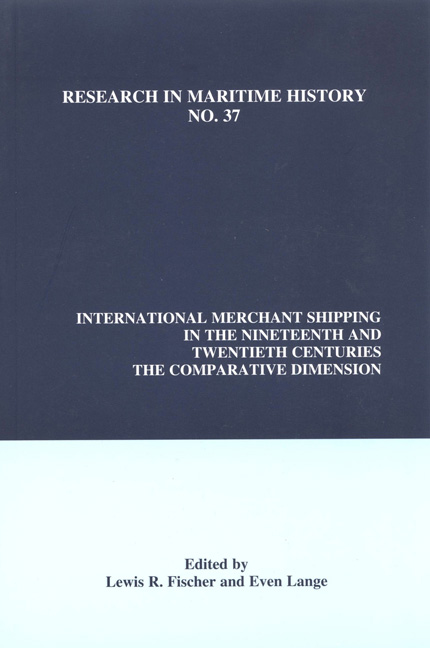Book contents
- Frontmatter
- Contents
- Contributors' Notes
- Contributors
- Introduction
- “Growth, Diversification and Globalization: Main Trends in International Shipping since 1850”
- “Norwegian Shipping in the Twentieth Century”
- “The Greek Shipping Sector, c. 1850-2000”
- “A Guide to the Emergence of Japan's Modern Shipping Industries”
- “British Shipping from the Late Nineteenth Century to the Present”
- “North of England Shipowners and Their Business Connections in the Nineteenth Century”
- “Network Structures, Processes and Dynamics: Inter-firm Cooperative Frameworks in the Shipping Industry”
“Network Structures, Processes and Dynamics: Inter-firm Cooperative Frameworks in the Shipping Industry”
- Frontmatter
- Contents
- Contributors' Notes
- Contributors
- Introduction
- “Growth, Diversification and Globalization: Main Trends in International Shipping since 1850”
- “Norwegian Shipping in the Twentieth Century”
- “The Greek Shipping Sector, c. 1850-2000”
- “A Guide to the Emergence of Japan's Modern Shipping Industries”
- “British Shipping from the Late Nineteenth Century to the Present”
- “North of England Shipowners and Their Business Connections in the Nineteenth Century”
- “Network Structures, Processes and Dynamics: Inter-firm Cooperative Frameworks in the Shipping Industry”
Summary
Shipping has always been a “networked” industry, and its history therefore has much to offer in terms of insights into the structure, processes and dynamics of this organizational form. Maritime historians are well placed to contribute to the further development of network theory and analysis. We have rich empirical data that can support longitudinal investigations aimed at exploring the causes of change as network-based marine enterprises adapted to new environmental conditions. Detailed reports and correspondence among shipowners and their business partners expose the processes of networking and their social/ cultural underpinnings. Corporate records and share registers enable us to explore the structure of maritime networks and their constituent vertical, horizontal and diversified links. Highly developed skills conducting biographical studies, which influenced the writing of many early company histories, provide a platform to examine the social and cultural links that shaped the networks employed by maritime businessmen who represented a group recognized for their considerable upward mobility. Finally, as an international industry, whose members interacted with a variety of government agencies at home and abroad, shipping offers a wonderful opportunity to explore networks in action on the global stage.
This essay examines recent network theory in order to highlight questions that maritime historians can explore using the rich resources and welldeveloped skills at their disposal. The first section considers networks as a distinctive framework that operates within and alongside of other structures, such as hierarchies and markets. The second part of the article examines network structures and the various links that might sustain them. Next, we probe the contents of these supporting ties, exploring in particular their knowledge and information-handling functions. The final section describes computer software that supports the study of networks.
Networks as Cooperative Structures
A network may be defined as an informal web of participants who band together to mobilize resources needed to carry out some form of mutually rewarding endeavour. Members contribute capital, physical assets, information and/or reputation to support transactions that individuals would not be able to undertake independendy given the limitations of the resources at their disposal or the degree of risk involved. Among their collective and personal attributes, reputation is of salient importance to participants because it mitigates the uncertainty surrounding exchanges, especially those involving information and knowledge.
- Type
- Chapter
- Information
- International Merchant Shipping in the Nineteenth and Twentieth CenturiesThe Comparative Dimension, pp. 165 - 178Publisher: Liverpool University PressPrint publication year: 2008



